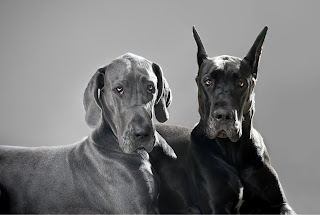Dog blog 21 - 1 + 1 = 2?
 1 + 1 = 2?
1 + 1 = 2?The Dog has never been that great at maths. Dave - pictured with Sammy in their "Lord of the Sith" poses for their weekly Star Wars night - thinks he's slightly better at it, but only because he can count up to eleven.
One of the most baffling things for the Dog is the idea that "1 + 1 = 2". Dave tried to explain it to me once using apples. We were originally going to try to work out what "2 + 1 = 3" means, but Dave was hungry and mumbled something about that being terribly very complicated - and ate one of them.
Dave tries to explain it all
"So here's one apple. A tasty pink lady apple.", said Dave. "And here's another one.".
"That's two apples. So 1 + 1 = 2". Job done Dave thought.
"But what if one of the apples is green, and the other one is red?", I asked.
Now that didn't make a lot of sense to Dave. He's colour blind for a start, like most dogs, so wasn't really sure what I was getting at: "There'd still be two apples".
"Ok Dave, but what if it was an apple and an orange?".
"Well, there'd be just one apple then."
"Yes", I said. "But there'd be 2 pieces of fruit.".
This was all a bit too much for Dave who, by now, was getting hungry again and decided to see what would happen if he ate both apples. Which unfortunately backfired on our endeavours. And, as it turned out, on Dave a couple of hours later. Apples disagree with him.
Something missing?
What "1 + 1 = 2" doesn't really tell you is what you're counting. With an apple and an orange, you get 2 pieces of fruit - for sure - but it doesn't make much sense to the Dog to describe that as "1 + 1 = 2". It seems more accurate to say "1a(f) + 1o(f) = 2f(a + o)". Where the "f" represents fruit of course.
"1 + 1 = 2", then, seems to be saying that "there are 2 items of the same class". That's easier maybe on the right hand side of the equation. But tricky on the left: 1a is not the same as 1o. It's only when they're accepted as belonging to the same unifying class "f" that they can be counted together.
The loneliest number
And there seems to be a problem for "1" on its own. Are there really 2 identical "1"s? In every way? Can ideas occupy the same space-time? If they can't, are they in fact truly "identical"? The proposition itself seems to suggest that, in some way, the later "1" is an "other" 1.
All that makes the Dog's head hurt, and I think it's because for all its appearance of logical purity, "1 + 1 = 2" is actually more "open textured" a phrase than that: you still need to read in the answer to "well, one what?".
Enough brain hurty for the now. Off to chase rabbits. And to make it easier, I'm just going to chase one.


Mein Arithmetikhundfreund,
ReplyDeleteIn a possibly related matter, dimensional analysis, often used in physics, may shed a little light. Essentially, that two different metrics cannot be added together in any equation - length cannot be added directly to mass, nor speed to time, and so on.
In this context, in fruit-counting queries context is everything. Whilst there is no physical metric (you are adding two dimensionless numbers, not physical properties), you can impose additional conditions on your arithmetic in your question. Thus by asking how many fruit there are and casting your net wide in the tricky field of hesperidian-pomaceous semantics, it is perfectly valid to add an apple to an orange.
(Which gives you an apporange).
Yours etc.
Doktor Oetker